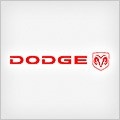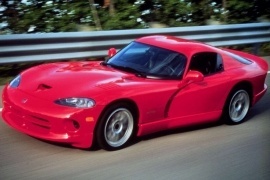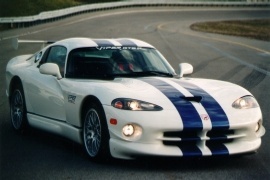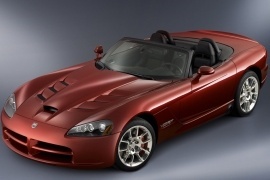
DODGE Viper
Generations Timeline, Specs and Pictures

Dodge made a special version for the Viper in 1999 and named it ACR after the American Club Racing and carried over some GT2 technologies.
The carmaker paid homage to the Viper GTS-R World Champion FIA GT2 race car with the ACR special edition. It turned it and enhanced its racing abilities, so private owners could use it on race weekends. Even though it was not a racing car, the technologies used made it as close as possible and still keep the car road-legal.
With or without stripes on it, the Viper ACR sported a few differences from the rest of the Viper range. Dodge tried to modify the car, so it was harder to be replicated in home garages, at least for a while. The ACR lost its fog lights from the bumper, and the resulting holes were connected to air intakes that brought more air to the new K&N air filters. Thanks to the new system, the engine could breathe more easily and provided some extra ponies. From the sides, the BBS light-alloy wheels were specifically designed for the Viper ACR. Unlike the GT2 edition, introduced in 1998, the ACR didn’t feature a big wing in the back.
Inside, Dodge removed everything it could to make the car lighter. Gone were the a/c unit, the stereo, and the speakers. Thus, it shaved about 60 lbs (27.2 kg) from the total car’s weight. Apart from the fog lights, which were not available, the A/C and the stereo were on the options list so the driver wouldn’t sweat too much on the track.
Under the hood, the ACR featured the same eight-liter V-10 engine. Thanks to the new air-intake system, the car provided 466 hp, ten more than the regular Viper. Unlike its normal version, the ACR featured stiffer suspension.

Dodge won the 1997 FIA GT2 Championship and did-it again in 1998, so the carmaker decided that it could build a special street-version of the winning car: the 1999 Viper GT2.
Whether Dodge dropped a V-10 engine under the hood of a sports car or built an oversized go-kart around that powerplant, the result was magnificent. The result was a rocket-car for its times, and the Viper remained in the Motorsport History as the David that defeated Porsche Goliath on its game. Worth mentioning that in 1998, Viper Team Oreca won nine out of ten races of the FIA GT2 Championship. Dodge took the 1-2 class win at the 1998 24h LeMans race to seal its racing capability. Doge celebrated that incredible performance by building 100 road-cars that resembled the racing vehicles.
First of all, they were all white with two blue stripes from the nose to the rear wing. Then, it added 18” BBS light-alloy wheels, cast especially for this GT2 and the ACR club-racing editions Vipers. There was a special air-splitter at the front, and on the sides, the carmaker installed ground-effect rocker panels. In the back, Dodge mounted a carbon-fiber wing that stood there just for the looks since it didn’t offer downforce or lift.
While Dodge made the exterior resemble the race-car version, the interior looked more civilized, at the mid-way between the race- and the street-version. A five-point harness was fitted as standard. The GT2 version featured leather-wrapped sports-bucket seats with black bolstering and blue mid-sections. Worth mentioning the white dials in the instrument cluster and, of course, the small metallic badge on the center console.
Under the hood, Dodge squeezed more power and torque from the massive 8.0-liter engine. Thus, it resulted in the quickest Viper from its times.

The Dodge Viper released in 2012 at the New York Auto Show and was the fifth generation of the model, the first one being unveiled in 1991, with its prototype tested in 1989.
The Viper is a 2-seater coupe available in 2 trim levels: the base Viper and the GTS version. The new generation returned with a new design and a new interior. Although it used the same 8.4-liter V10 hand-assembled engine and had the same chassis, they were both improved and upgraded. The engine output increased with 40 hp and the chassis had a two-mode dampers.
The engine produced 640 hp and 600 pound-feet of torque, and the power was sent to the wheels through a 6-speed manual transmission. The car could sprint from 0 to 60 mph in just 3.7 seconds. The engineers managed to reduce the car’s weight with around 100 pounds, compared to its predecessor, by reworking the several areas of the chassis.
The new models were hand built at the Conner Avenue Assembly Plant in Detroit.
With a more powerful engine came more efficient brakes, being equipped with 4-piston Brembo brakes with fixed-aluminum caliper and vented rotors.
The interior was upgraded with new premium materials and technologies. The new generation is the most spacious released, as the floor pan and the bulkhead have been extended.

When Dodge dropped a V10 truck engine into a roadster back in 1991, it made the biggest, heaviest and most powerful front-engine go-kart in the world.
The Viper had to be the answer for the European supercars and its performances were far better than anyone expected. Its speed and handling abilities transformed it into a mad track-weapon. Its unique styling was unmistakable. Even though it was introduced as a roadster, the carmaker offered it in a coupe version later on. Dodge prepared the ACR (American Club Racer) version for weekend racing, which was even more hard-core than its regular model.
In 2007, Dodge presented the fourth Viper generation in both shapes: coupe and roadster. Unlike the original version, it didn’t feature any safety arch or B-pillar. In the ACR version, the car featured a carbon-fiber front splitter and front canards on the sides to divert the airflow to the sides. The six vents on the hood helped to cool the engine while the side extraction ones took the air out of the wheel-wells. In the back, the carmaker installed a huge, adjustable wing.
The Viper ACR interior showed a minimalist style with a tall center console where the gear-stick was mounted closer to the driver and one cup-holder. On the center stack, Dodge placed an audio system and the climate control. These were offered as an option since the racer did not need them on the track. Its sport bucket-seats with high bolstering offered great support during high-speed cornering.
But the real changes were under the bodywork. Even though it was an open-top vehicle designed for racetrack and cruising, the carmaker installed adjustable K&W suspension and bigger Brembo disc brakes in all corners. The engine was still a V-10, while the stability control was still unknown for the Viper.

Dodge introduced the fourth generation of its monstrous supercar Viper in 2007 as a 2008 model year and showed a meaner, aggressive look.
With a design that left no room for errors, the Viper was already a feared competitor on the tracks, even by the best European supercars from that era. Moreover, the carmaker prepared a special version for the coupe-shaped model named ACR (American Club Racer), which was a hard-core track weapon.
In 2007, Dodge presented the fourth Viper generation in both shapes: coupe and roadster. The coupe sported the same two bumps on the roof to provide more headroom for its occupants, especially when they wore helmets. At the front, the new angular headlights and the six vents on the hood were an unmistakable feature for the 2007 model. One of the Viper’s key features was the side-mounted exhausts, which made an impressive noise.
The Viper showed a minimalist interior with leather seats, an infotainment unit, and a cup holder. Its infotainment system was good only for its look since the speakers couldn’t fight against the loud engine. Dodge considered installing just the minimum quantity of sound-deadening materials to pass the mandatory safety requirements.
Under the hood, the Viper featured an upgraded V-10 engine that punched out with 600 hp. As a concession, the carmaker installed ABS on the vehicle, but there was no stability control or traction control on it. Everything was on the driver.

Dodge introduced the third generation of the Viper in 2002 in the roadster version and, in the following year, it came with the coupe version.
By 2003, the Viper was already a phenomenon in the supersport arena. Its nameplate was known on the racetracks around the world, placed next to the Ferrari, Lamborghini, or Aston Martin. It wasn’t only the U.S. sportscar anymore. But it was still the same bad guy you like to hang-out with, but you don’t want to see with.
Ralph Gilles designed the coupe based on the roadster created by Osamu Shikado in 1999. While it was an important step ahead of the original design, it remained the same aggressive-looking coupe with a long hood and a bubbled roof. Its headlights received a triangular shape that resembled the eyes of a snake. In the back, the lip-spoiler on the lift-gate produced more emotions than downforce.
Inside, the spartan cabin left room only for two people separated by a wide center console. The gear-stick was thick and strong like the whole car depended on it. Since it was the best-known American supercar, the designer decided to create a memorable experience for the driver and tilted the center stack toward the driver’s seat. Unlike its predecessor, the 2003 Viper featured a cup-holder next to the parking brake, near the power-windows buttons.
The 2003 Viper came with a better braking system and featured ABS. Under the hood, the carmaker installed an 8.3-liter V-10 engine paired to a standard six-speed manual gearbox. It sent all the power to the rear wheels via a limited-slip differential.

Dodge introduced the third generation of the Viper SRT10 Roadster in 2002 and reignited the horsepower war among the American sportscars.
The Viper has stirred the market ever since its introduction back in 1991. It was unveiled as a roadster, and the coupe version came later. In its twelve years on the market, it became known on racetracks around the world, competing against the Ferrari, Lamborghini, or Aston Martin. Its brute force and unforgiving platform made it a scary yet desired vehicle.
Osamu Shikado designed the roadster in 1999, but the final product suffered a few adjustments. Viper’s snake-eye-shaped headlights were already unique and recognized among car enthusiasts. The designer installed an air intake at the front of the hood’s power dome, and additional ten slats released the hot air from the engine compartment. On the sides, covered by the side sills, Doge installed the side exhausts, which returned to their original position. It was a true roadster, with only the windshield in front of the cabin and no other pillars. The canvas top was completely hidden behind the seats.
Inside, the spartan cabin left room only for two people separated by a wide center console. The gear-stick was thick and strong like the whole car depended on it. Since it was the best-known American supercar, the designer decided to create a memorable experience for the driver and tilted the center stack toward the driver’s seat. Unlike its predecessor, the 2003 Viper featured a cup-holder next to the parking brake, near the power-windows buttons.
The 2003 Viper came with a better braking system and featured ABS. Under the hood, the carmaker installed an 8.3-liter V-10 engine paired to a standard six-speed manual gearbox. It sent all the power to the rear wheels via a limited-slip differential.

In 1995 Dodge introduced the second generation of the Viper, and it offered it into a coupe shape that added more practicality without spoiling the performance.
The Viper was the car that brought back the Dodge brand on the car magazines’ front pages. Thanks to it, Chrysler ended the Corvette domination as the American fastest sports car and started a new car culture. It was a true daily driver supercar in the coupe form, just with a truck engine at the front.
Its long, curved hood featured an air scoop in the middle and side vents. The design team drew the lines with a purpose and in a flamboyant style. The fenders were big and featured vents behind the wheels. The duck-tail in the rear was both elegant and useful. Even the two bubbles on the roof, named Guerney-bubbles after the tall racing driver, served to increase the headroom, mostly when racing helmets were used.
Inside, the Viper GTS Coupe featured air-conditioning and roll-down power windows. It was not possible on the first generation, which featured zip-folding side windows and a canvas top not bigger than a handkerchief. The sport-bucket seats were meant to keep its occupants in place during hard cornering. In the back, only the sloped window could have been open to access the trunk, which was large enough.
They said that the car was built around the engine. It might be true since the 450 hp V10 engine was huge. It was cast by Lamborghini, which at that time belonged to Chrysler. There was only one transmission available, a 6-speed manual.

Dodge Viper is one of the most famous cars in the world, with numerous appearances in movies, TV shows and computer games plus a lot of variations and cars based on its original model.
The first generation Dodge Viper RT/10 arrived in 1991 and proved to be a bit tricky to drive at high speeds than first expected, especially due to its high-performance engine which was capable of developing a maximum power of 400 hp. Top speed was rated at about 290 km/h while the 0 to 100 km/h acceleration could be done in approximately 4.6 seconds. Fuel consumption was obviously a bit neglected, with about 11 and 19.9 mpg in city and highway mode, respectively.























































